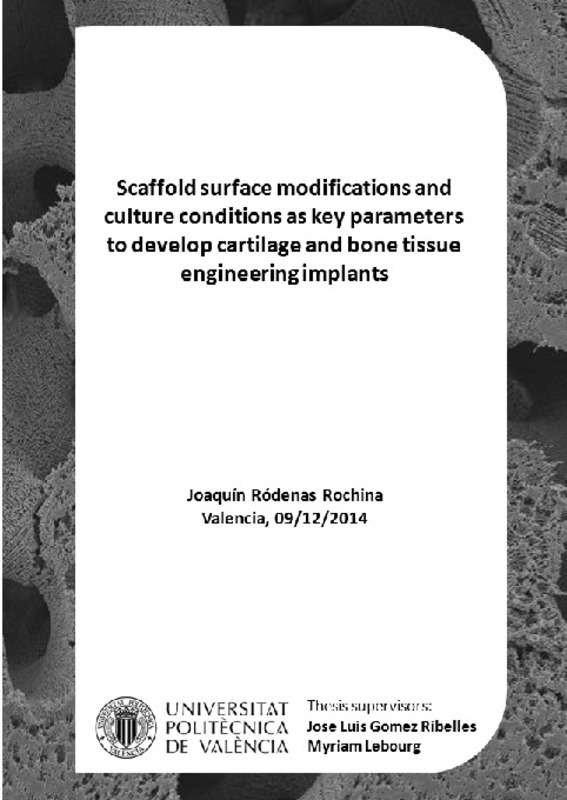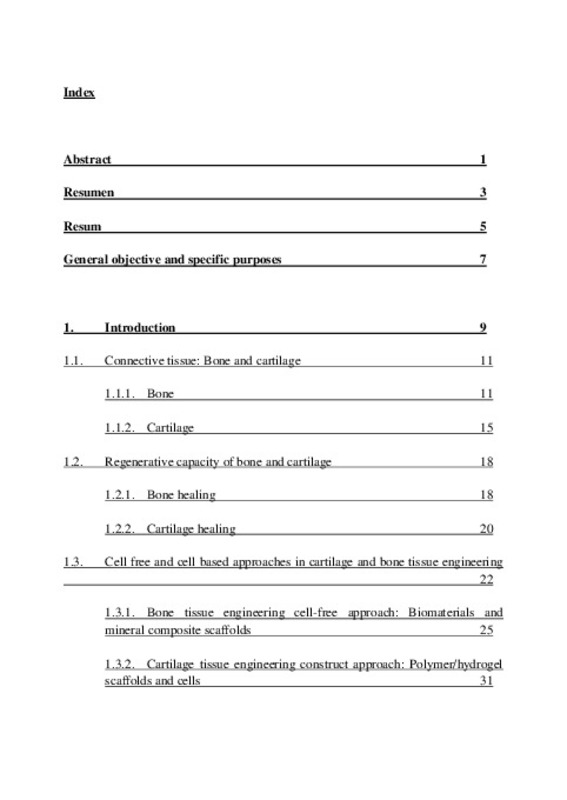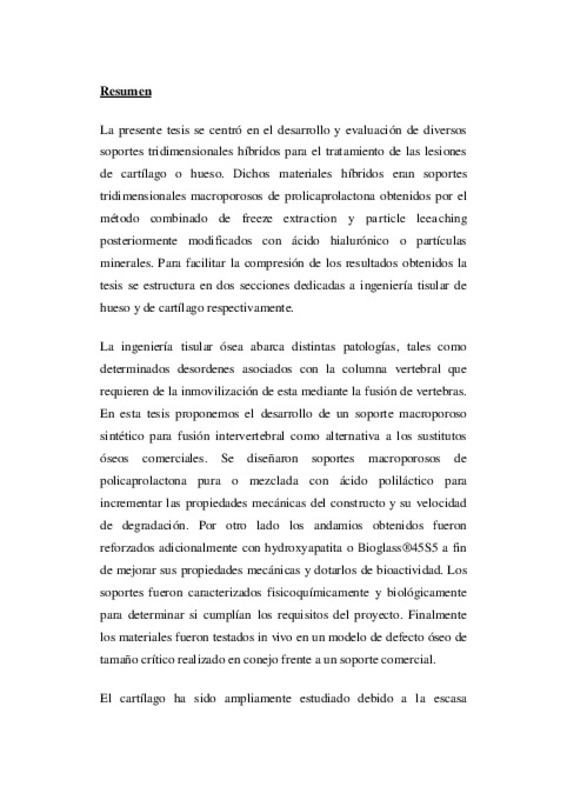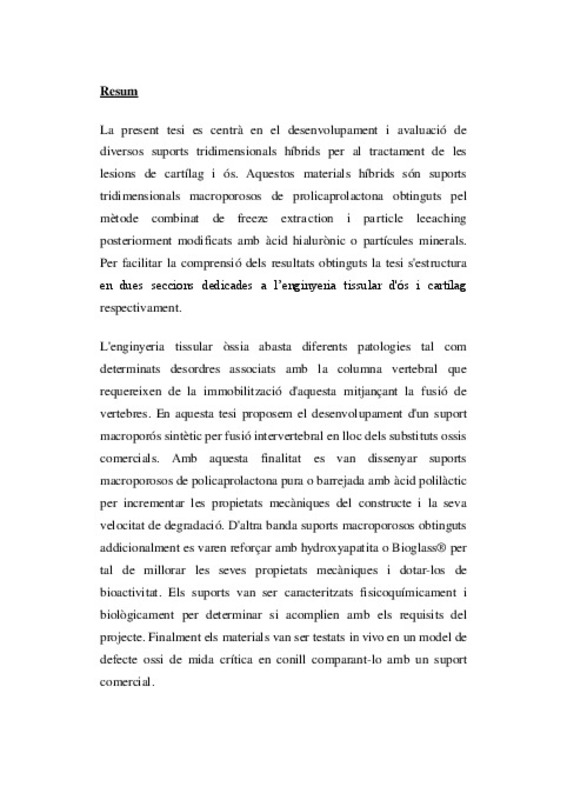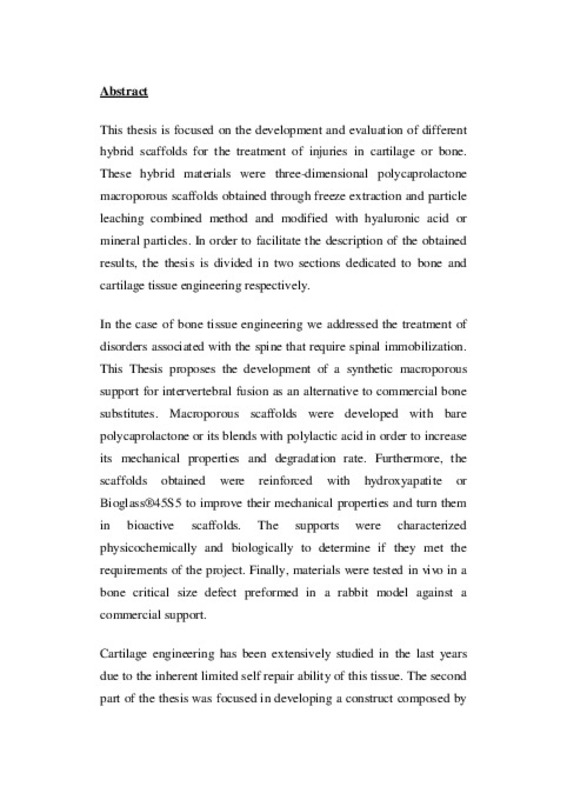- RiuNet repositorio UPV
- :
- Investigación
- :
- Tesis doctorales
- :
- Ver ítem
JavaScript is disabled for your browser. Some features of this site may not work without it.
Buscar en RiuNet
Listar
Mi cuenta
Estadísticas
Ayuda RiuNet
Admin. UPV
Scaffold surface modifications and culture conditions as key parameters to develop cartilage and bone tissue engineering implants
Mostrar el registro sencillo del ítem
Ficheros en el ítem
| dc.contributor.advisor | Gómez Ribelles, José Luís
|
es_ES |
| dc.contributor.advisor | Lebourg, Myriam Madeleine
|
es_ES |
| dc.contributor.author | Ródenas Rochina, Joaquín
|
es_ES |
| dc.date.accessioned | 2015-03-31T06:02:01Z | |
| dc.date.available | 2015-03-31T06:02:01Z | |
| dc.date.created | 2015-01-13 | es_ES |
| dc.date.issued | 2015-03-31 | es_ES |
| dc.identifier.uri | http://hdl.handle.net/10251/48526 | |
| dc.description.abstract | This thesis is focused on the development and evaluation of different hybrid scaffolds for the treatment of injuries in cartilage or bone. These hybrid materials were three-dimensional polycaprolactone macroporous scaffolds obtained through freeze extraction and particle leaching combined method and modified with hyaluronic acid or mineral particles. In order to facilitate the description of the obtained results, the thesis is divided in two sections dedicated to bone and cartilage tissue engineering respectively. In the case of bone tissue engineering we addressed the treatment of disorders associated with the spine that require spinal immobilization. This Thesis proposes the development of a synthetic macroporous support for intervertebral fusion as an alternative to commercial bone substitutes. Macroporous scaffolds were developed with bare polycaprolactone or its blends with polylactic acid in order to increase its mechanical properties and degradation rate. Furthermore, the scaffolds obtained were reinforced with hydroxyapatite or Bioglass®45S5 to improve their mechanical properties and turn them in bioactive scaffolds. The supports were characterized physicochemically and biologically to determine if they met the requirements of the project. Finally, materials were tested in vivo in a bone critical size defect preformed in a rabbit model against a commercial support. Cartilage engineering has been extensively studied in the last years due to the inherent limited self repair ability of this tissue. The second part of the thesis was focused in developing a construct composed by in vitro differentiated chondrocyte like cells in a hybrid scaffold for cartilage tissue engineering. Polycaprolactone hybrid substrates coated with hyaluronic acid scaffold were developed obtaining a substrate with positive influence over the development of chondrocyte phenotype in culture and able to protect the cells from excessive mechanical loading in the joint. Cell-scaffolds constructs were obtained combining hybrid scaffolds with mesenchymal stem cells and differentiating them to chondrocytes using chondrogenic culture medium combined with hypoxia, mechanical stimulus or co-culture. Finally the cellularized scaffolds were mechanically, biochemically and histologically characterized to determine the production of extracellular matrix and expression of chondrogenic markers. | en_EN |
| dc.language | Inglés | es_ES |
| dc.publisher | Universitat Politècnica de València | es_ES |
| dc.rights | Reserva de todos los derechos | es_ES |
| dc.subject | Tissue engineering | es_ES |
| dc.subject | Bone | |
| dc.subject | Cartilage | |
| dc.subject | Composite scaffolds | |
| dc.subject.classification | MAQUINAS Y MOTORES TERMICOS | es_ES |
| dc.title | Scaffold surface modifications and culture conditions as key parameters to develop cartilage and bone tissue engineering implants | es_ES |
| dc.type | Tesis doctoral | es_ES |
| dc.identifier.doi | 10.4995/Thesis/10251/48526 | es_ES |
| dc.rights.accessRights | Abierto | es_ES |
| dc.contributor.affiliation | Universitat Politècnica de València. Departamento de Biotecnología - Departament de Biotecnologia | es_ES |
| dc.description.bibliographicCitation | Ródenas Rochina, J. (2015). Scaffold surface modifications and culture conditions as key parameters to develop cartilage and bone tissue engineering implants [Tesis doctoral]. Universitat Politècnica de València. https://doi.org/10.4995/Thesis/10251/48526 | es_ES |
| dc.description.accrualMethod | TESIS | es_ES |
| dc.type.version | info:eu-repo/semantics/acceptedVersion | es_ES |
| dc.relation.pasarela | TESIS\4293 | es_ES |
Este ítem aparece en la(s) siguiente(s) colección(ones)
-
Tesis doctorales [5389]






